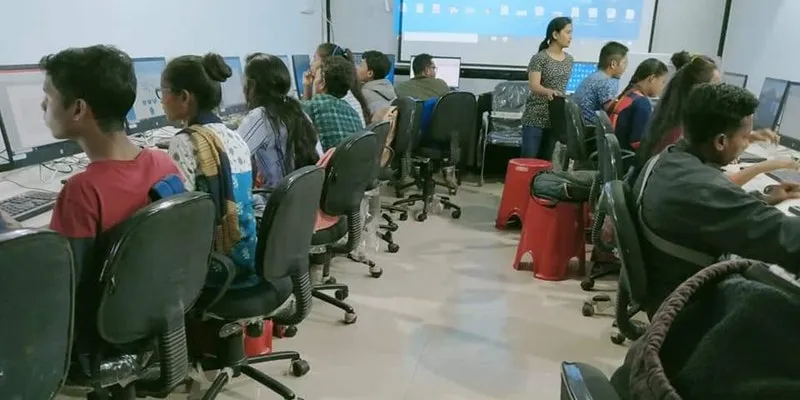This IAS officer is changing the face of education and development in Jharkhand
Very few people can walk the talk on social development and change. IAS officer Aditya Ranjan is one such person, who inspires others by changing the state of education in the Shingbhum district of Jharkhand.
Across Shingbhum district in Jharkhand, the walls of 650 anganwadis (rural childcare centres) are painted with numbers and alphabets. Known as Building as Learning Aid (BALA), this is one of the many things that intrigue children in the district – one of the poorest constituencies of India – that is rife with malnutrition among children.
This and other facilities such as better sanitation, starting basic education, and providing nutritional food are all the results of efforts of IAS officer Aditya Ranjan and his initiative ‘Model Anganwadi’.

IAS Officer Aditya Ranjan
“Earlier, besides the lack of infrastructure, the sevakis (workers) would cook khichdi, feed the children, and send them home. There was no concept of teaching,” he says.
So, the officer took matters into his own hands by creating a timetable, specifying lessons for each day, from numbers to alphabets, and paintings, among other things.
“It is said that the first 1,000 to 2,000 days of a child are very important for their mental growth,” he shares, adding that this is the idea behind the initiative.
The inspiration
After quitting a job at Oracle, Aditya cleared the coveted civil services exam in 2015. It was in his early years of probation in Deoghar district when the idea of model anganwadis first struck him.
He found inspiration in a widowed sevika who lived alone and used her meagre monthly salary of Rs 4,500 to improvise one such anganwadi, which was well-loved by children as well.
“It was a wow moment for me to see a caretaker singlehandedly convert an anganwadi into such a nice place – much better than any playschool I can think of. And if she can contribute from her own pocket, why can't the government do so?” he recalls.
As a result, in December 2018, he started replicating the same model in Shingbhum, “with more advanced tech", adds Aditya.

Officer Aditya Ranjan at one of the model anganwadis
As per the Census of 2011, Jharkhand has recorded a literacy rate of 67 percent against the national average of 74.04 percent.
The model anganwadis have also played a critical role in giving adequate nutrition needed for a child’s growth and development. Aditya shares that a baseline survey of the heights and weights of the kids from a year ago shows improvement.
He notes that more children are willing to come to the centre regularly and engage in the activities. At the same time, Aditya emphasises that a behavioural change in parents is as important because a child spends a major chunk of the day with them.
The challenges
Aditya aims to convert 1,000 out of the 2,330 centres in the district into model anganwadis by the end of this March. Speaking on the delays in progress, he cites constraints regarding land, building, and poor infrastructure makes.
“So, we began with the ones that are in better condition,” the officer adds.
However, the biggest challenge, he says, was the workers who resisted certain changes. Aditya says, “While they appreciated infrastructural improvements, there was a lot of resistance in terms of use of BALA, teaching, and taking care of the children.”
As a result, he started conducting residential training programmes for the caretakers on the importance of the initiative and how the centres should work.
Further, to ensure that the resources are properly used, he introduced the E-Samiksha app to record daily activities at the centres. Aditya checks the backend at the end of each month to see how many centres are opening regularly and conducting classes.
Empowering through education
A reservation-based district, residents of Shingbhum also faces challenges of lack of skills and knowledge sharing with outsiders.
“Longevity of the district is very low and when government officials die before retiring, a member of his family will get a job in the government, regardless of their educational background. There is the perpetuity of inefficiency here,” he explains.

So, he went on to make the District e-Governance society (DeGs) programme more effective to raise computer literacy and soft skills, including how to walk and talk professionally, speak at interviews and group discussions, and the ways to use mobile phones.
With more than 2,100 students trained so far, Aditya says, “There are kids who have never seen computers who’d stare at the mouse and ask what to do with it. They get scared it might break while using. And all of them learn under the programme.”
Aditya tells us that last year’s Teachers’ Day was one of the most memorable days. His students, some of whom had earned jobs at Indian Railways or become teachers themselves, had come to his office to express gratitude.
“I asked them what they want, and they said that they wanted coaching centres to prepare for competitive exams,” he says.
As a result, this February, Aditya opened his first coaching centre in Shingbhum where 1,200 students are being trained. Divided into three batches of 400 students each, they learn English, Maths, Business, and general studies.
“I want to train them in these areas for six months so that they know simple words and sentence making,” he explains, adding that he takes the class for general studies.
Once the six-month-long course is completed, Aditya plans on categorising them based on a mix of choice and merit, and creates 10 to 20 batches focussed on different exams.
Having grown up in the suburbs of Bakora, Jharkhand himself, this is IAS Officer Aditya Ranjan’s way of showing that change does begin at home.
(Edited by Saheli Sen Gupta)








